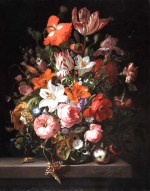Virtual Series: Travel the World of Art w/the D.I.A. - 'In The Garden'
Thursday, October 36:30—7:30 PMVirtual

This talk by a Detroit Institute of Arts docent explores the hidden meanings behind images of flowers, plants and garden which are featured in some of our most favorite works of art. This program will be presented by a Detroit Institute of Arts docent.
About the DIA -
The DIA Founded in 1885, the museum was originally located on Jefferson Avenue, but, due to its rapidly expanding collection, moved to the current site on Woodward Avenue in 1927. The Beaux-Arts building, designed by Paul Cret, was immediately referred to as the "temple of art." Two wings were added in the 1960s and 1970s, and a major renovation and expansion that began in 1999 was completed in 2007. The museum covers 658,000 square feet that includes more than 140 galleries, a 1,140-seat auditorium, a 333-seat lecture/recital hall, an art reference library, and a state-of-the-art conservation services laboratory. The DIA's collection is among the top six in the United States, with more than 65,000 works. The foundation was laid by William Valentiner, who was director from 1924 to 1945 and acquired many important works that established the framework of today's collections. Among his notable acquisitions are Mexican artist Diego Rivera's Detroit Industry fresco cycle, which Rivera considered his most successful work, and Vincent van Gogh's Self-Portrait, the first Van Gogh painting to enter a U.S. museum collection.
A hallmark of the DIA is the diversity of the collection. In addition to outstanding American, European, Modern and Contemporary, and Graphic art, the museum holds significant works of African, Asian, Native American, Oceanic, Islamic, and Ancient art. In 2000, the DIA established the General Motors Center for African American Art as a curatorial department in order to broaden the museum's collection of African American art.
Registration for this event has now closed.